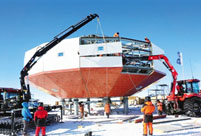 Amazing cliff diving in cold winter
Amazing cliff diving in cold winter
 Enjoy Sochi 2014 in slow motion
Enjoy Sochi 2014 in slow motion
 University student sentenced to death for poisoning roommate
University student sentenced to death for poisoning roommate
 Chinese lunar New Year celebrated in San Francisco
Chinese lunar New Year celebrated in San Francisco
 Taiwan Lantern Festival 2014
Taiwan Lantern Festival 2014
 Haiyang Yangge: make up
Haiyang Yangge: make up
 China's top 10 richest cities
China's top 10 richest cities
 President Xi visits garrison troops in Inner Mongolia
President Xi visits garrison troops in Inner Mongolia
 Turnip sculptures amaze tourists in Qingdao
Turnip sculptures amaze tourists in QingdaoBEIJING, Feb. 21 -- With over 150,000 cars in Lhasa, and the number growing by 200 a day, the bittersweet joys of the modern auto industry are hitting the ancient city hard.
Dong Zhihong is director of the Lhasa Vehicle Management Station. He told Xinhua that poor traffic management and bad driving brought regular traffic jams to the 1,300-year-old city, a city which, until 60 years ago, did not even have a highway.
In the rush hour, downtown Lhasa routinely slips into gridlock and parking spaces are almost always difficulty to find.
Tibet's vehicle ownership -- about one in ten -- exceeds the national average of one in 13. Whether Lhasa can avoid systemic traffic problems of mots big Chinese cities is a question which will test the foresight of Lhasa's government.
Lhasa, understandably, has the highest vehicle ownership in Tibet, with one in six people owning a car. Each year, nearly 80,000 people take driving tests. Equestrian culture is deeply ingrained in the Tibetan consciousness after aeons of nomadic herding, and cars are quickly supplanting horses as a popular family assets, along with the customary yak, cattle and sheep.
Nyima, a herder from Nyanrong County in northern Tibet, has a sedan and a minivan. His family no longer eke out their living on husbandry alone, but have interests in long-distance passenger transportation.
"A horse, a gun and a knife used to be the standard equipment for a Tibetan man to set out for his dreams. Now, we barely ride horses. When tending the flocks, we ride motorcycles," said Nyima.
He Gang of the Tibet Academy of Social Sciences, believes Tibetans have said goodbye to the days of struggling to make ends meet and embraced the auto era.
NEW CHALLENGES
Judging by what is happening in China's more developed cities, the "auto era" has become synonymous with gridlock and pollution.
"Compared with other cities in China, Lhasa's traffic management is still based on manpower rather than intelligent systems," Dong Zhihong said. "Traffic signs are incomplete in some places. The population is too dense in the downtown areas and public transportation is insufficient."
Moreover, rapid transit systems are absent from Lhasa. The city abounds with dead ends and by-passes are yet to be opened.
Tashi Aphel, deputy chief of Lhasa's traffic police, claims the city authorities have come up with plenty of ways to remedy the situation. More buses and taxis will go into service this year and mass transit systems are planned.
The city is also considering intelligent traffic control, including intelligent traffic lights which automatically adjust waiting intervals according to real traffic flow, and a route guidance system to keep drivers informed of road conditions and possible detours, Aphel said.
In a preemptive measure, the city started fighting pollution in 2010, when all vehicles, including motorcycles, were required to have emissions tests at authorized centers, supported by random roadside tests. The exhaust test is a prerequisite to car registration and sales.
Lhasa's air remains some of the best in the world, but in the first 10 months of 2013, the city recorded "excellent" in only 94.4 percent of air quality tests. Nonetheless, clean air remains a major tourist attraction.
OXYGEN DEFICIENCY
Having clean air is one thing, but keeping it that way is quite another with rising vehicle ownership. The city is considering introduction of the China National Vehicle Pollutant Emission Standards (CNVPES) IV this year, according to Wang Junmin, deputy chief of Lhasa's environmental protection bureau.
CNVPES III is the most widely used standard in China. Only Beijing has adopted the strictest Jing V standards (equivalent to Euro V standards). Shanghai and a dozen provinces including Jiangsu, Zhejiang and Guangdong follow CNVPES IV and are considering tightening the regime this year.
New standards could cut emissions from the CNVPES III level by 30 percent to 50 percent.
Using a stricter standard in Tibet could be particularly challenging. Oxygen deficiency and low air pressure result in incomplete combustion of fuel and that means more pollutants than at lower altitude, according to Wang Junmin. Cleaner fuels adapted to local thin air are being developed.
Zhang Shengguo, a senior technician in Lhasa, echoed the need to rise to national challenges in a local way.
"Altitude sickness affects not only people but also cars," he said.Zhang works for Wanrong Investment Co., a Lhasa auto dealer.
"Power deficiency, less sensitive brakes and higher fuel consumption are common problems we see," said he.
He recalled that last summer, a Kia Carnival could not be started because incomplete combustion through oxygen deficiency caused carbon deposits in the engine.
"Our solution is simple and unique. Attach an oxygen bag to the vehicle's intake pipe and increase the oxygen content in engine," said he.
 Most gorgeous female celebs in Chi-pao
Most gorgeous female celebs in Chi-pao Second round of test kicks off at Beijing Film Academy
Second round of test kicks off at Beijing Film Academy Ancient Qiang people had vertically grown teeth
Ancient Qiang people had vertically grown teeth Top 10 Chinese youth’s favorite seaside destinations
Top 10 Chinese youth’s favorite seaside destinations Traditional Tibetan clothing tailors
Traditional Tibetan clothing tailors In photos: Unveiling Taishan station
In photos: Unveiling Taishan station Beautiful moments of family reunion
Beautiful moments of family reunion 10 Valentine's Day ideas for couples
10 Valentine's Day ideas for couples Let's get married today!
Let's get married today! Chinese warplanes C919 to appear at Singapore Airshow 2014
Chinese warplanes C919 to appear at Singapore Airshow 2014 Ruins of Shang Dynasty's structure unearthed in Shaanxi
Ruins of Shang Dynasty's structure unearthed in Shaanxi  Intercity high speed train in operation
Intercity high speed train in operation Severe coldness freezes large parts of China
Severe coldness freezes large parts of China  Beautiful moments of Sochi
Beautiful moments of Sochi  It's not just performing this year
It's not just performing this yearDay|Week|Month